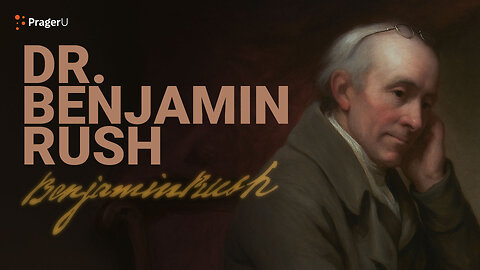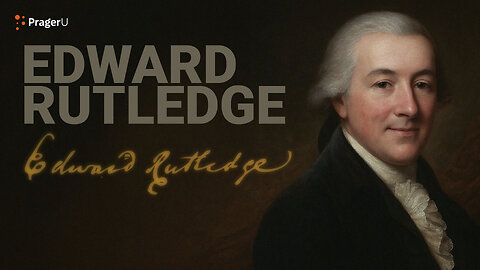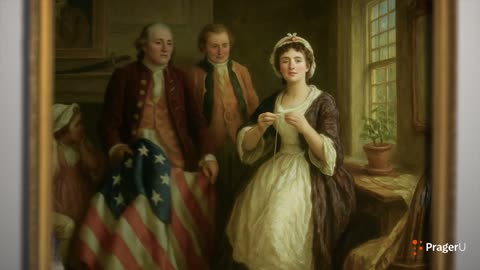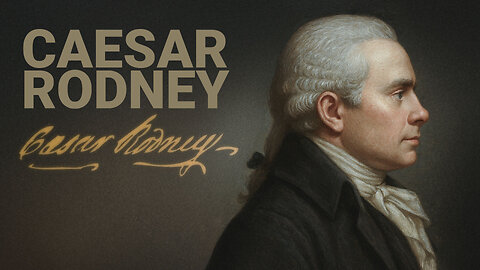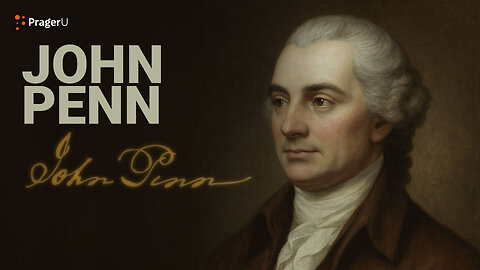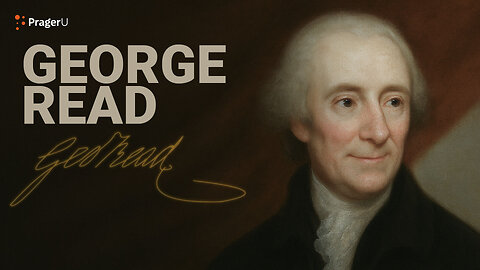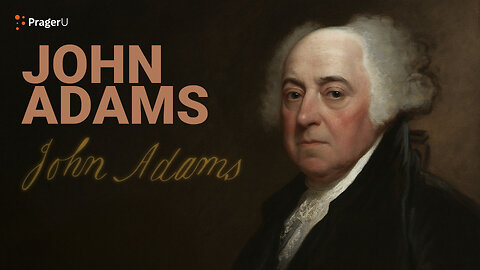-
Road to Liberty: Roger Sherman | The White House Founders Museum | PragerU
 PragerURoger Sherman, born on April 19, 1721, in Newton, Massachusetts, was the only person to have signed all four of the most significant documents in our nation’s early history: the Continental Association from the first Continental Congress, the Declaration of Independence, the Articles of Confederation, and the United States Constitution. The son of a farmer and cobbler, Sherman received minimal education. Nevertheless, he was an avid learner who made extensive use of his father’s sizable personal library. In 1743, Sherman moved to New Milford, Connecticut. There, he worked as a surveyor and storekeeper. He was admitted to the bar in 1754, despite having no formal legal training, and began his legal career. Sherman entered politics in 1755 as justice of the peace and a member of Connecticut’s General Assembly. During the Second Continental Congress, Sherman was appointed to the Committee of Five where he helped review and refine Thomas Jefferson’s drafts of the Declaration of Independence. Following America’s War for Independence, Sherman participated in the Constitutional Convention and proposed the Great Compromise (also known as the “Connecticut Compromise”), establishing a bicameral legislature with equal state representation in the Senate and population-based representation in the House. In 1784, Sherman was elected as the mayor of New Haven, Connecticut and held this position concurrently alongside others until his death. Sherman was elected to serve in the U.S. House of Representatives in 1789. In 1791, he was chosen to fill a vacancy in the U.S. Senate. Two years later, he fell ill with typhoid fever and died. 🇺🇸 Celebrate America's 250th With Purpose. As our nation approaches its 250th birthday, PragerU is seizing this historic moment to educate the next generation about America’s founding, values, and greatness. Discover more 👉 https://l.prageru.com/4khLIqv 📲 Watch our content ad-free on our app: https://prageru.onelink.me/3bas/vgyxvm79 Donate to PragerU: https://l.prageru.com/4jiAT85 Follow PragerU on social media: Instagram ➡️ https://www.instagram.com/prageru/ X/Twitter ➡️ https://twitter.com/prageru Facebook ➡️ https://www.facebook.com/prageru/ YouTube ➡️ https://www.youtube.com/@PragerU TikTok ➡️ https://www.tiktok.com/@prageru4.52K views 1 comment
PragerURoger Sherman, born on April 19, 1721, in Newton, Massachusetts, was the only person to have signed all four of the most significant documents in our nation’s early history: the Continental Association from the first Continental Congress, the Declaration of Independence, the Articles of Confederation, and the United States Constitution. The son of a farmer and cobbler, Sherman received minimal education. Nevertheless, he was an avid learner who made extensive use of his father’s sizable personal library. In 1743, Sherman moved to New Milford, Connecticut. There, he worked as a surveyor and storekeeper. He was admitted to the bar in 1754, despite having no formal legal training, and began his legal career. Sherman entered politics in 1755 as justice of the peace and a member of Connecticut’s General Assembly. During the Second Continental Congress, Sherman was appointed to the Committee of Five where he helped review and refine Thomas Jefferson’s drafts of the Declaration of Independence. Following America’s War for Independence, Sherman participated in the Constitutional Convention and proposed the Great Compromise (also known as the “Connecticut Compromise”), establishing a bicameral legislature with equal state representation in the Senate and population-based representation in the House. In 1784, Sherman was elected as the mayor of New Haven, Connecticut and held this position concurrently alongside others until his death. Sherman was elected to serve in the U.S. House of Representatives in 1789. In 1791, he was chosen to fill a vacancy in the U.S. Senate. Two years later, he fell ill with typhoid fever and died. 🇺🇸 Celebrate America's 250th With Purpose. As our nation approaches its 250th birthday, PragerU is seizing this historic moment to educate the next generation about America’s founding, values, and greatness. Discover more 👉 https://l.prageru.com/4khLIqv 📲 Watch our content ad-free on our app: https://prageru.onelink.me/3bas/vgyxvm79 Donate to PragerU: https://l.prageru.com/4jiAT85 Follow PragerU on social media: Instagram ➡️ https://www.instagram.com/prageru/ X/Twitter ➡️ https://twitter.com/prageru Facebook ➡️ https://www.facebook.com/prageru/ YouTube ➡️ https://www.youtube.com/@PragerU TikTok ➡️ https://www.tiktok.com/@prageru4.52K views 1 comment -
Road to Liberty: Dr. Benjamin Rush | The White House Founders Museum | PragerU
 PragerUA Physician, an abolitionist, and an early adopter of the cause for independence, Dr. Benjamin Rush was one of the most influential founding fathers. Born on January 4, 1746, in Byberry Pennsylvania, Rush was raised in a pious Presbyterian family and was educated at the College of New Jersey (now Princeton) where he graduated in 1760 at the age of 14. He pursued medicine, apprenticing in Philadelphia and earning his medical degree from the University of Edinburgh in 1768. He returned to Philadelphia in 1769 and established a medical practice. That same year, he became a professor of chemistry at the College of Philadelphia, and in 1770 he published America’s first chemistry textbook. Rush’s medical contributions were groundbreaking, albeit controversial. He pioneered American psychiatric mental health treatment and is often referred to as the “father of American psychiatry.” Following the Revolutionary War, Rush opened the United States’ first free medical clinic, the Philadelphia Dispensary. Rush was also an early advocate for the education of women and the abolition of slavery. A steadfast patriot, Rush joined the Sons of Liberty and influenced Thomas Paine’s Common Sense, a pivotal pro-independence pamphlet. He was elected to the Continental Congress in 1776 and signed the Declaration of Independence as a representative of Pennsylvania. Rush was not reelected that following year, due to his opposition to the Pennsylvania state constitution, and subsequently accepted the position of Surgeon General in the Middle Department of the Continental Army. Rush was highly critical of the conditions in which soldiers were being treated and angrily resigned his post in 1778. He briefly supported efforts to remove General George Washington from his post, a stance that cost Rush considerable social and political capital. However, largely due to his medical and civic contributions, Rush continued to play an important role in American politics. Appointed treasurer of the U.S. Mint by President John Adams, Rush also helped achieve the historic reconciliation between Adams and Thomas Jefferson. 🇺🇸 Celebrate America's 250th With Purpose. As our nation approaches its 250th birthday, PragerU is seizing this historic moment to educate the next generation about America’s founding, values, and greatness. Discover more 👉 https://l.prageru.com/4khLIqv 📲 Watch our content ad-free on our app: https://prageru.onelink.me/3bas/vgyxvm79 Donate to PragerU: https://l.prageru.com/4jiAT85 Follow PragerU on social media: Instagram ➡️ https://www.instagram.com/prageru/ X/Twitter ➡️ https://twitter.com/prageru Facebook ➡️ https://www.facebook.com/prageru/ YouTube ➡️ https://www.youtube.com/@PragerU TikTok ➡️ https://www.tiktok.com/@prageru4.38K views 2 comments
PragerUA Physician, an abolitionist, and an early adopter of the cause for independence, Dr. Benjamin Rush was one of the most influential founding fathers. Born on January 4, 1746, in Byberry Pennsylvania, Rush was raised in a pious Presbyterian family and was educated at the College of New Jersey (now Princeton) where he graduated in 1760 at the age of 14. He pursued medicine, apprenticing in Philadelphia and earning his medical degree from the University of Edinburgh in 1768. He returned to Philadelphia in 1769 and established a medical practice. That same year, he became a professor of chemistry at the College of Philadelphia, and in 1770 he published America’s first chemistry textbook. Rush’s medical contributions were groundbreaking, albeit controversial. He pioneered American psychiatric mental health treatment and is often referred to as the “father of American psychiatry.” Following the Revolutionary War, Rush opened the United States’ first free medical clinic, the Philadelphia Dispensary. Rush was also an early advocate for the education of women and the abolition of slavery. A steadfast patriot, Rush joined the Sons of Liberty and influenced Thomas Paine’s Common Sense, a pivotal pro-independence pamphlet. He was elected to the Continental Congress in 1776 and signed the Declaration of Independence as a representative of Pennsylvania. Rush was not reelected that following year, due to his opposition to the Pennsylvania state constitution, and subsequently accepted the position of Surgeon General in the Middle Department of the Continental Army. Rush was highly critical of the conditions in which soldiers were being treated and angrily resigned his post in 1778. He briefly supported efforts to remove General George Washington from his post, a stance that cost Rush considerable social and political capital. However, largely due to his medical and civic contributions, Rush continued to play an important role in American politics. Appointed treasurer of the U.S. Mint by President John Adams, Rush also helped achieve the historic reconciliation between Adams and Thomas Jefferson. 🇺🇸 Celebrate America's 250th With Purpose. As our nation approaches its 250th birthday, PragerU is seizing this historic moment to educate the next generation about America’s founding, values, and greatness. Discover more 👉 https://l.prageru.com/4khLIqv 📲 Watch our content ad-free on our app: https://prageru.onelink.me/3bas/vgyxvm79 Donate to PragerU: https://l.prageru.com/4jiAT85 Follow PragerU on social media: Instagram ➡️ https://www.instagram.com/prageru/ X/Twitter ➡️ https://twitter.com/prageru Facebook ➡️ https://www.facebook.com/prageru/ YouTube ➡️ https://www.youtube.com/@PragerU TikTok ➡️ https://www.tiktok.com/@prageru4.38K views 2 comments -
Road to Liberty: Edward Rutledge | The White House Founders Museum | PragerU
 PragerUEdward Rutledge, born in Charleston, South Carolina, was the youngest signer of the Declaration of Independence. The son of Dr. John Rutledge, an Irish immigrant and physician, and Sarah Hext, a wealthy South Carolinian, Rutledge grew up in an aristocratic family. Rutledge studied law in England and was admitted to the English Bar in 1772 before returning to Charleston, where he established a thriving legal practice. In 1774, he married the sister of Arthur Middleton, a fellow signer of the Declaration of Independence. Rutledge’s political career began in 1774 when, at the age of 24, he was elected to the first Continental Congress to represent South Carolina alongside his brother John. Initially, Rutledge favored reconciliation with Britain. However, he ultimately supported the Declaration of Independence, reportedly persuading the South Carolina delegation to vote in the affirmative. A proud American patriot, Rutledge served as a captain in the Charleston Artillery Battalion during the Revolutionary War. He was captured by the British during the 1780 Siege of Charleston and was imprisoned until a prisoner exchange in July 1781. After the war, Rutledge returned home to South Carolina, serving in the state legislature from 1782-1798. Here Rutledge fought against opening the African slave trade and voted to ratify the U.S. Constitution. Elected governor in 1798, Rutledge died in office at the age of 50. 🇺🇸 Celebrate America's 250th With Purpose. As our nation approaches its 250th birthday, PragerU is seizing this historic moment to educate the next generation about America’s founding, values, and greatness. Discover more 👉 https://l.prageru.com/4khLIqv 📲 Watch our content ad-free on our app: https://prageru.onelink.me/3bas/vgyxvm79 Donate to PragerU: https://l.prageru.com/4jiAT85 Follow PragerU on social media: Instagram ➡️ https://www.instagram.com/prageru/ X/Twitter ➡️ https://twitter.com/prageru Facebook ➡️ https://www.facebook.com/prageru/ YouTube ➡️ https://www.youtube.com/@PragerU TikTok ➡️ https://www.tiktok.com/@prageru4.21K views 2 comments
PragerUEdward Rutledge, born in Charleston, South Carolina, was the youngest signer of the Declaration of Independence. The son of Dr. John Rutledge, an Irish immigrant and physician, and Sarah Hext, a wealthy South Carolinian, Rutledge grew up in an aristocratic family. Rutledge studied law in England and was admitted to the English Bar in 1772 before returning to Charleston, where he established a thriving legal practice. In 1774, he married the sister of Arthur Middleton, a fellow signer of the Declaration of Independence. Rutledge’s political career began in 1774 when, at the age of 24, he was elected to the first Continental Congress to represent South Carolina alongside his brother John. Initially, Rutledge favored reconciliation with Britain. However, he ultimately supported the Declaration of Independence, reportedly persuading the South Carolina delegation to vote in the affirmative. A proud American patriot, Rutledge served as a captain in the Charleston Artillery Battalion during the Revolutionary War. He was captured by the British during the 1780 Siege of Charleston and was imprisoned until a prisoner exchange in July 1781. After the war, Rutledge returned home to South Carolina, serving in the state legislature from 1782-1798. Here Rutledge fought against opening the African slave trade and voted to ratify the U.S. Constitution. Elected governor in 1798, Rutledge died in office at the age of 50. 🇺🇸 Celebrate America's 250th With Purpose. As our nation approaches its 250th birthday, PragerU is seizing this historic moment to educate the next generation about America’s founding, values, and greatness. Discover more 👉 https://l.prageru.com/4khLIqv 📲 Watch our content ad-free on our app: https://prageru.onelink.me/3bas/vgyxvm79 Donate to PragerU: https://l.prageru.com/4jiAT85 Follow PragerU on social media: Instagram ➡️ https://www.instagram.com/prageru/ X/Twitter ➡️ https://twitter.com/prageru Facebook ➡️ https://www.facebook.com/prageru/ YouTube ➡️ https://www.youtube.com/@PragerU TikTok ➡️ https://www.tiktok.com/@prageru4.21K views 2 comments -
Road to Liberty: Betsy Ross | The White House Founders Museum | PragerU
 PragerUBetsy Ross is credited with stitching the first United States flag—a symbol of freedom that has since become the marker of American identity, patriotism, and pride. Born Elizabeth Griscom on January 1, 1752, in Gloucester City, New Jersey, Betsy Ross was the eighth of seventeen children (though only nine survived into adulthood) and was raised by a Quaker family in Philadelphia. After schooling, she apprenticed under John Webster, becoming a skilled seamstress and upholsterer. In 1773, she eloped with John Ross, which got her expelled from the Quaker community, since they did not approve of Betsy marrying a non-Quaker. Together, they ran an upholstery shop in Philadelphia, but John tragically died in 1776. A widow at 24, Betsy continued running the shop—and according to legend, General George Washington, Robert Morris, and George Ross visited her in the summer of 1776. Washington showed her a sketch of a flag with thirteen red and white stripes and thirteen six-pointed stars and Betsy advised minor changes. This legend was made famous by her grandson William Canby in 1870 to the Pennsylvania Historical Society, and while there is no definitive evidence, Betsy and the American flag are now inextricably linked. Throughout the Revolutionary War, and for decades after, Betsy continued to make flags—many through government contracts. In 1811, for example, Betsy made over 50 garrison flags for the US Arsenal on the Schuylkill River. In 1777, Betsy married a merchant sailor, Joseph Ashburn, and they had two daughters, but Joseph was captured by a British warship and died in a British prison in 1782. John Claypoole, a fellow Patriot who had been imprisoned with Joseph, visited Betsy to bring her the news that her husband had died. Over the course of the year, Betsy and John fell in love. They married and had five daughters, enjoying 34 years of marriage before John's death in 1817. Betsy retired at the age of 76, completely blind, and died peacefully on January 30, 1836, shortly after her 84th birthday. 🇺🇸 Celebrate America's 250th With Purpose. As our nation approaches its 250th birthday, PragerU is seizing this historic moment to educate the next generation about America’s founding, values, and greatness. Discover more 👉 https://l.prageru.com/4khLIqv 📲 Watch our content ad-free on our app: https://prageru.onelink.me/3bas/vgyxvm79 Donate to PragerU: https://l.prageru.com/4jiAT85 Follow PragerU on social media: Instagram ➡️ https://www.instagram.com/prageru/ X/Twitter ➡️ https://twitter.com/prageru Facebook ➡️ https://www.facebook.com/prageru/ YouTube ➡️ https://www.youtube.com/@PragerU TikTok ➡️ https://www.tiktok.com/@prageru4.55K views 2 comments
PragerUBetsy Ross is credited with stitching the first United States flag—a symbol of freedom that has since become the marker of American identity, patriotism, and pride. Born Elizabeth Griscom on January 1, 1752, in Gloucester City, New Jersey, Betsy Ross was the eighth of seventeen children (though only nine survived into adulthood) and was raised by a Quaker family in Philadelphia. After schooling, she apprenticed under John Webster, becoming a skilled seamstress and upholsterer. In 1773, she eloped with John Ross, which got her expelled from the Quaker community, since they did not approve of Betsy marrying a non-Quaker. Together, they ran an upholstery shop in Philadelphia, but John tragically died in 1776. A widow at 24, Betsy continued running the shop—and according to legend, General George Washington, Robert Morris, and George Ross visited her in the summer of 1776. Washington showed her a sketch of a flag with thirteen red and white stripes and thirteen six-pointed stars and Betsy advised minor changes. This legend was made famous by her grandson William Canby in 1870 to the Pennsylvania Historical Society, and while there is no definitive evidence, Betsy and the American flag are now inextricably linked. Throughout the Revolutionary War, and for decades after, Betsy continued to make flags—many through government contracts. In 1811, for example, Betsy made over 50 garrison flags for the US Arsenal on the Schuylkill River. In 1777, Betsy married a merchant sailor, Joseph Ashburn, and they had two daughters, but Joseph was captured by a British warship and died in a British prison in 1782. John Claypoole, a fellow Patriot who had been imprisoned with Joseph, visited Betsy to bring her the news that her husband had died. Over the course of the year, Betsy and John fell in love. They married and had five daughters, enjoying 34 years of marriage before John's death in 1817. Betsy retired at the age of 76, completely blind, and died peacefully on January 30, 1836, shortly after her 84th birthday. 🇺🇸 Celebrate America's 250th With Purpose. As our nation approaches its 250th birthday, PragerU is seizing this historic moment to educate the next generation about America’s founding, values, and greatness. Discover more 👉 https://l.prageru.com/4khLIqv 📲 Watch our content ad-free on our app: https://prageru.onelink.me/3bas/vgyxvm79 Donate to PragerU: https://l.prageru.com/4jiAT85 Follow PragerU on social media: Instagram ➡️ https://www.instagram.com/prageru/ X/Twitter ➡️ https://twitter.com/prageru Facebook ➡️ https://www.facebook.com/prageru/ YouTube ➡️ https://www.youtube.com/@PragerU TikTok ➡️ https://www.tiktok.com/@prageru4.55K views 2 comments -
Road to Liberty: Caesar Rodney | The White House Founders Museum | PragerU
 PragerUCaesar Rodney was born October 7, 1728, on a sprawling farm in Kent County, Delaware. After losing his father in his youth, Rodney inherited wealth and responsibility that he used for the good of the new nation. At 27, Rodney was commissioned High Sheriff of Kent County Delaware, and he served as an officer in the French and Indian War. Among the many public offices he held, Rodney later joined the Stamp Act Congress and the Continental Congress. No Delawarean since has matched the sheer number of positions held by Rodney and the rigor of his public life. His defining moment came on July 1, 1776, when, despite battling asthma and a disfiguring facial cancer, Rodney rode 80 miles through a thunderstorm and the dead of night from Dover to Philadelphia. Arriving at Independence Hall on July 2nd, spurs clinking, he broke Delaware’s deadlock, casting the decisive vote for the Declaration of Independence. It was an act of duty, courage, and treason that cemented his patriotic legacy. As wartime governor and major-general, Rodney led Delaware’s militia and supported Washington’s Continental Army with all the money, supplies, and manpower his state could muster. At a low moment for the Revolutionary cause, he secured military equipment with money from his own pocket. Later, the Continental Congress elected him President of Delaware in 1778, a position he used to stabilize the state’s war-torn finances and politics. As the War came to a close, Rodney’s health deteriorated under the strain of cancer. He became too ill to remain in political life, but as a final gesture of respect for Rodney’s honorable service to Delaware, the 1783-1784 Legislative Council elected him as Speaker. He died on June 26, 1784, leaving behind no children, but rather, a nation shaped by his sacrifice. 🇺🇸 Celebrate America's 250th With Purpose. As our nation approaches its 250th birthday, PragerU is seizing this historic moment to educate the next generation about America’s founding, values, and greatness. Discover more 👉 https://l.prageru.com/4khLIqv 📲 Watch our content ad-free on our app: https://prageru.onelink.me/3bas/vgyxvm79 Donate to PragerU: https://l.prageru.com/4jiAT85 Follow PragerU on social media: Instagram ➡️ https://www.instagram.com/prageru/ X/Twitter ➡️ https://twitter.com/prageru Facebook ➡️ https://www.facebook.com/prageru/ YouTube ➡️ https://www.youtube.com/@PragerU TikTok ➡️ https://www.tiktok.com/@prageru4.9K views 2 comments
PragerUCaesar Rodney was born October 7, 1728, on a sprawling farm in Kent County, Delaware. After losing his father in his youth, Rodney inherited wealth and responsibility that he used for the good of the new nation. At 27, Rodney was commissioned High Sheriff of Kent County Delaware, and he served as an officer in the French and Indian War. Among the many public offices he held, Rodney later joined the Stamp Act Congress and the Continental Congress. No Delawarean since has matched the sheer number of positions held by Rodney and the rigor of his public life. His defining moment came on July 1, 1776, when, despite battling asthma and a disfiguring facial cancer, Rodney rode 80 miles through a thunderstorm and the dead of night from Dover to Philadelphia. Arriving at Independence Hall on July 2nd, spurs clinking, he broke Delaware’s deadlock, casting the decisive vote for the Declaration of Independence. It was an act of duty, courage, and treason that cemented his patriotic legacy. As wartime governor and major-general, Rodney led Delaware’s militia and supported Washington’s Continental Army with all the money, supplies, and manpower his state could muster. At a low moment for the Revolutionary cause, he secured military equipment with money from his own pocket. Later, the Continental Congress elected him President of Delaware in 1778, a position he used to stabilize the state’s war-torn finances and politics. As the War came to a close, Rodney’s health deteriorated under the strain of cancer. He became too ill to remain in political life, but as a final gesture of respect for Rodney’s honorable service to Delaware, the 1783-1784 Legislative Council elected him as Speaker. He died on June 26, 1784, leaving behind no children, but rather, a nation shaped by his sacrifice. 🇺🇸 Celebrate America's 250th With Purpose. As our nation approaches its 250th birthday, PragerU is seizing this historic moment to educate the next generation about America’s founding, values, and greatness. Discover more 👉 https://l.prageru.com/4khLIqv 📲 Watch our content ad-free on our app: https://prageru.onelink.me/3bas/vgyxvm79 Donate to PragerU: https://l.prageru.com/4jiAT85 Follow PragerU on social media: Instagram ➡️ https://www.instagram.com/prageru/ X/Twitter ➡️ https://twitter.com/prageru Facebook ➡️ https://www.facebook.com/prageru/ YouTube ➡️ https://www.youtube.com/@PragerU TikTok ➡️ https://www.tiktok.com/@prageru4.9K views 2 comments -
Road to Liberty: John Penn | The White House Founders Museum | PragerU
 PragerUJohn Penn, born May 17, 1741, in Caroline County, Virginia, emerged from an upbringing of little formal education to eventually become one of just 56 men to etch his name on the Declaration of Independence. After his father died in 1759, Penn discovered a newfound motivation to educate himself and through the aid of his uncle pursued legal studies. In 1762, Penn became licensed to practice law in Virginia, where he worked until the cause of the American Revolution called him to enter public life. After moving to North Carolina, Penn’s fiery opposition to the Stamp Act ignited his political ascent. By 1775, Penn was on his way to the Second Continental Congress. Upon his arrival, Penn declared, “My first wish is for America to be free.” In Philadelphia, Penn’s uncompromising passion sparked clashes with his colleagues, notably Continental Congress President Henry Laurens. According to some historians, the two men nearly dueled in a vacant Philadelphia lot, but decided to make peace on the way there. Penn signed both the Declaration of Independence and the Articles of Confederation, making his name one of 16 that both documents bear. Later, as one of three men on the Board of War for North Carolina, Penn bolstered General Nathaniel Greene against the weakening Cornwallis campaign, forcing the British retreat through North Carolina to Yorktown that won the war. When America needed Penn most, no sacrifice was too great for independence. Check out all of our Road to Liberty videos on PragerU.com 👉 https://l.prageru.com/47bZRRz 🇺🇸 Celebrate America's 250th With Purpose. As our nation approaches its 250th birthday, PragerU is seizing this historic moment to educate the next generation about America’s founding, values, and greatness. Discover more 👉 https://l.prageru.com/4khLIqv 📲 Watch our content ad-free on our app: https://prageru.onelink.me/3bas/vgyxvm79 Donate to PragerU: https://l.prageru.com/4jiAT85 Follow PragerU on social media: Instagram ➡️ https://www.instagram.com/prageru/ X/Twitter ➡️ https://twitter.com/prageru Facebook ➡️ https://www.facebook.com/prageru/ YouTube ➡️ https://www.youtube.com/@PragerU TikTok ➡️ https://www.tiktok.com/@prageru5.51K views 2 comments
PragerUJohn Penn, born May 17, 1741, in Caroline County, Virginia, emerged from an upbringing of little formal education to eventually become one of just 56 men to etch his name on the Declaration of Independence. After his father died in 1759, Penn discovered a newfound motivation to educate himself and through the aid of his uncle pursued legal studies. In 1762, Penn became licensed to practice law in Virginia, where he worked until the cause of the American Revolution called him to enter public life. After moving to North Carolina, Penn’s fiery opposition to the Stamp Act ignited his political ascent. By 1775, Penn was on his way to the Second Continental Congress. Upon his arrival, Penn declared, “My first wish is for America to be free.” In Philadelphia, Penn’s uncompromising passion sparked clashes with his colleagues, notably Continental Congress President Henry Laurens. According to some historians, the two men nearly dueled in a vacant Philadelphia lot, but decided to make peace on the way there. Penn signed both the Declaration of Independence and the Articles of Confederation, making his name one of 16 that both documents bear. Later, as one of three men on the Board of War for North Carolina, Penn bolstered General Nathaniel Greene against the weakening Cornwallis campaign, forcing the British retreat through North Carolina to Yorktown that won the war. When America needed Penn most, no sacrifice was too great for independence. Check out all of our Road to Liberty videos on PragerU.com 👉 https://l.prageru.com/47bZRRz 🇺🇸 Celebrate America's 250th With Purpose. As our nation approaches its 250th birthday, PragerU is seizing this historic moment to educate the next generation about America’s founding, values, and greatness. Discover more 👉 https://l.prageru.com/4khLIqv 📲 Watch our content ad-free on our app: https://prageru.onelink.me/3bas/vgyxvm79 Donate to PragerU: https://l.prageru.com/4jiAT85 Follow PragerU on social media: Instagram ➡️ https://www.instagram.com/prageru/ X/Twitter ➡️ https://twitter.com/prageru Facebook ➡️ https://www.facebook.com/prageru/ YouTube ➡️ https://www.youtube.com/@PragerU TikTok ➡️ https://www.tiktok.com/@prageru5.51K views 2 comments -
Road to Liberty: George Read | The White House Founders Museum | PragerU
 PragerUGeorge Read, born on September 18, 1733, in Cecil County, Maryland, was a self-made lawyer and patriot who helped shape the foundation of American government. He studied law at an early age and, by 21, established a legal practice in Delaware, quickly becoming one of the colony’s most respected attorneys. In 1763, at 29, Read was appointed Attorney General for Lower Delaware by the British Crown, a position he held for over a decade. Though loyal to the law, Read hoped to resolve colonial grievances without war and initially sought reconciliation with Britain. In 1774, Read left his post to join the Continental Congress, continuing to advocate for compromise. However, as the push for independence became unavoidable, he signed the Declaration of Independence. In retaliation, British forces ransacked his home and captured his wife. Recognized for his contributions, Read was selected to draft Delaware’s first constitution, and is considered by some to be “the father” of Delaware. In 1777, he served as acting governor when the British captured his predecessor. A decade later, Read led Delaware’s delegation at the Constitutional Convention, where he strongly supported small state interests. After securing those rights, he urged Delaware to become the first state to ratify the U.S. Constitution. Read continued his public service as a U.S. Senator and later as Chief Justice of Delaware, a role he held until his death on September 21, 1798. Check out all of our Road to Liberty videos on PragerU.com 👉 https://l.prageru.com/47bZRRz 🇺🇸 Celebrate America's 250th With Purpose. As our nation approaches its 250th birthday, PragerU is seizing this historic moment to educate the next generation about America’s founding, values, and greatness. Discover more 👉 https://l.prageru.com/4khLIqv 📲 Watch our content ad-free on our app: https://prageru.onelink.me/3bas/vgyxvm79 Donate to PragerU: https://l.prageru.com/4jiAT85 Follow PragerU on social media: Instagram ➡️ https://www.instagram.com/prageru/ X/Twitter ➡️ https://twitter.com/prageru Facebook ➡️ https://www.facebook.com/prageru/ YouTube ➡️ https://www.youtube.com/@PragerU TikTok ➡️ https://www.tiktok.com/@prageru5.45K views 1 comment
PragerUGeorge Read, born on September 18, 1733, in Cecil County, Maryland, was a self-made lawyer and patriot who helped shape the foundation of American government. He studied law at an early age and, by 21, established a legal practice in Delaware, quickly becoming one of the colony’s most respected attorneys. In 1763, at 29, Read was appointed Attorney General for Lower Delaware by the British Crown, a position he held for over a decade. Though loyal to the law, Read hoped to resolve colonial grievances without war and initially sought reconciliation with Britain. In 1774, Read left his post to join the Continental Congress, continuing to advocate for compromise. However, as the push for independence became unavoidable, he signed the Declaration of Independence. In retaliation, British forces ransacked his home and captured his wife. Recognized for his contributions, Read was selected to draft Delaware’s first constitution, and is considered by some to be “the father” of Delaware. In 1777, he served as acting governor when the British captured his predecessor. A decade later, Read led Delaware’s delegation at the Constitutional Convention, where he strongly supported small state interests. After securing those rights, he urged Delaware to become the first state to ratify the U.S. Constitution. Read continued his public service as a U.S. Senator and later as Chief Justice of Delaware, a role he held until his death on September 21, 1798. Check out all of our Road to Liberty videos on PragerU.com 👉 https://l.prageru.com/47bZRRz 🇺🇸 Celebrate America's 250th With Purpose. As our nation approaches its 250th birthday, PragerU is seizing this historic moment to educate the next generation about America’s founding, values, and greatness. Discover more 👉 https://l.prageru.com/4khLIqv 📲 Watch our content ad-free on our app: https://prageru.onelink.me/3bas/vgyxvm79 Donate to PragerU: https://l.prageru.com/4jiAT85 Follow PragerU on social media: Instagram ➡️ https://www.instagram.com/prageru/ X/Twitter ➡️ https://twitter.com/prageru Facebook ➡️ https://www.facebook.com/prageru/ YouTube ➡️ https://www.youtube.com/@PragerU TikTok ➡️ https://www.tiktok.com/@prageru5.45K views 1 comment -
Road to Liberty: Thomas Jefferson | PragerU
 PragerUBorn on April 13, 1743, near present-day Charlottesville, Virginia, Thomas Jefferson was the primary drafter of the Declaration of Independence and the third President of the United States. The son of Peter Jefferson, a farmer and surveyor, and Jane Randolph, who hailed from a prominent Virginia family, Jefferson was educated by private tutors. He later attended the College of William and Mary, where he studied mathematics, philosophy, law, and languages. A man of the Enlightenment, he inherited a large estate from his father and designed his lifelong residence, Monticello. At 26, Jefferson entered the Virginia House of Burgesses, where his eloquence earned him a seat in the Second Continental Congress. At 33, he agreed to draft the Declaration of Independence upon John Adams’s insistence that Jefferson was more eloquent and well-liked than him. He penned the words that inspired thousands of young men to give their lives for the ideals that still ring true in the heart of every American: “that all men are created equal, that they are endowed by their Creator with certain unalienable Rights, that among these are Life, Liberty and the pursuit of Happiness.” Following a term as Governor of Virginia, Jefferson became Minister to France, strengthening ties with America’s key wartime ally. Under George Washington, he served as the first Secretary of State. In 1796, Jefferson was elected Vice President under John Adams, and in 1800, he defeated Adams in a fiercely contested election. As President, Jefferson orchestrated the Louisiana Purchase, doubling the nation’s size, and pursued neutrality during the Napoleonic Wars. After two terms, he retired to Monticello, where he corresponded with former rival John Adams. Jefferson died on July 4, 1826, the 50th anniversary of the Declaration of Independence. According to one account, just before he died, he asked his physician, “Is it the Fourth?” Watch the entire series here 👉 https://l.prageru.com/44uMMRY Your donation to PragerU makes a lasting impact. Give today ➡️ https://l.prageru.com/3Syr2PE 📲 Download the FREE PragerU app: https://l.prageru.com/43MsXXC Follow PragerU on social media! Instagram ➡️ (https://www.instagram.com/prageru/) X/Twitter ➡️ (https://twitter.com/prageru) Facebook ➡️ (https://www.facebook.com/prageru/) YouTube ➡️ (https://www.youtube.com/@PragerU) TikTok ➡️ (https://www.tiktok.com/@prageru)1.28K views
PragerUBorn on April 13, 1743, near present-day Charlottesville, Virginia, Thomas Jefferson was the primary drafter of the Declaration of Independence and the third President of the United States. The son of Peter Jefferson, a farmer and surveyor, and Jane Randolph, who hailed from a prominent Virginia family, Jefferson was educated by private tutors. He later attended the College of William and Mary, where he studied mathematics, philosophy, law, and languages. A man of the Enlightenment, he inherited a large estate from his father and designed his lifelong residence, Monticello. At 26, Jefferson entered the Virginia House of Burgesses, where his eloquence earned him a seat in the Second Continental Congress. At 33, he agreed to draft the Declaration of Independence upon John Adams’s insistence that Jefferson was more eloquent and well-liked than him. He penned the words that inspired thousands of young men to give their lives for the ideals that still ring true in the heart of every American: “that all men are created equal, that they are endowed by their Creator with certain unalienable Rights, that among these are Life, Liberty and the pursuit of Happiness.” Following a term as Governor of Virginia, Jefferson became Minister to France, strengthening ties with America’s key wartime ally. Under George Washington, he served as the first Secretary of State. In 1796, Jefferson was elected Vice President under John Adams, and in 1800, he defeated Adams in a fiercely contested election. As President, Jefferson orchestrated the Louisiana Purchase, doubling the nation’s size, and pursued neutrality during the Napoleonic Wars. After two terms, he retired to Monticello, where he corresponded with former rival John Adams. Jefferson died on July 4, 1826, the 50th anniversary of the Declaration of Independence. According to one account, just before he died, he asked his physician, “Is it the Fourth?” Watch the entire series here 👉 https://l.prageru.com/44uMMRY Your donation to PragerU makes a lasting impact. Give today ➡️ https://l.prageru.com/3Syr2PE 📲 Download the FREE PragerU app: https://l.prageru.com/43MsXXC Follow PragerU on social media! Instagram ➡️ (https://www.instagram.com/prageru/) X/Twitter ➡️ (https://twitter.com/prageru) Facebook ➡️ (https://www.facebook.com/prageru/) YouTube ➡️ (https://www.youtube.com/@PragerU) TikTok ➡️ (https://www.tiktok.com/@prageru)1.28K views -
Road to Liberty: John Adams | PragerU
 PragerUJohn Adams was a lawyer, statesman, and political theorist whose writings and intellect were vital to American independence. Born on October 30, 1735, in Braintree, Massachusetts, Adams attended Braintree Latin School and entered Harvard College at 16, later studying law and opening a practice in 1758. In 1764, he married Abigail Smith, with whom he had six children. Though initially hesitant to enter politics, the Stamp Act of 1765 spurred Adams to write essays supporting the Patriot cause and he became one of the most prominent voices for independence. Despite his fierce opposition to British rule, he defended the British soldiers in the Boston Massacre, believing that no one should be denied the right to a fair trial. In 1774, Adams was selected as one of Massachusetts’ delegates to the First Continental Congress. He returned the following year for the Second Continental Congress, where he helped draft the Declaration of Independence. Adams wrote Abigail, “The Second Day of July 1776, will be the most memorable Epocha in the History of America.” In 1789, Adams became the first Vice President, serving under George Washington. He was inaugurated as President on March 4, 1797. He avoided war with France and preserved national unity during a volatile period. He was the first president to live in the White House, leaving office in 1801. In later years, Adams renewed his friendship with his political rival, Thomas Jefferson. On July 4, 1826, the 50th anniversary of the Declaration, Adams died at age 90, reportedly saying, “Jefferson still survives.” Unbeknownst to him, Jefferson had died hours earlier that same day. Watch the entire series here 👉 https://l.prageru.com/44uMMRY Your donation to PragerU makes a lasting impact. Give today ➡️ https://l.prageru.com/3Syr2PE 📲 Download the FREE PragerU app: https://l.prageru.com/43MsXXC Follow PragerU on social media! Instagram ➡️ (https://www.instagram.com/prageru/) X/Twitter ➡️ (https://twitter.com/prageru) Facebook ➡️ (https://www.facebook.com/prageru/) YouTube ➡️ (https://www.youtube.com/@PragerU) TikTok ➡️ (https://www.tiktok.com/@prageru)1.24K views
PragerUJohn Adams was a lawyer, statesman, and political theorist whose writings and intellect were vital to American independence. Born on October 30, 1735, in Braintree, Massachusetts, Adams attended Braintree Latin School and entered Harvard College at 16, later studying law and opening a practice in 1758. In 1764, he married Abigail Smith, with whom he had six children. Though initially hesitant to enter politics, the Stamp Act of 1765 spurred Adams to write essays supporting the Patriot cause and he became one of the most prominent voices for independence. Despite his fierce opposition to British rule, he defended the British soldiers in the Boston Massacre, believing that no one should be denied the right to a fair trial. In 1774, Adams was selected as one of Massachusetts’ delegates to the First Continental Congress. He returned the following year for the Second Continental Congress, where he helped draft the Declaration of Independence. Adams wrote Abigail, “The Second Day of July 1776, will be the most memorable Epocha in the History of America.” In 1789, Adams became the first Vice President, serving under George Washington. He was inaugurated as President on March 4, 1797. He avoided war with France and preserved national unity during a volatile period. He was the first president to live in the White House, leaving office in 1801. In later years, Adams renewed his friendship with his political rival, Thomas Jefferson. On July 4, 1826, the 50th anniversary of the Declaration, Adams died at age 90, reportedly saying, “Jefferson still survives.” Unbeknownst to him, Jefferson had died hours earlier that same day. Watch the entire series here 👉 https://l.prageru.com/44uMMRY Your donation to PragerU makes a lasting impact. Give today ➡️ https://l.prageru.com/3Syr2PE 📲 Download the FREE PragerU app: https://l.prageru.com/43MsXXC Follow PragerU on social media! Instagram ➡️ (https://www.instagram.com/prageru/) X/Twitter ➡️ (https://twitter.com/prageru) Facebook ➡️ (https://www.facebook.com/prageru/) YouTube ➡️ (https://www.youtube.com/@PragerU) TikTok ➡️ (https://www.tiktok.com/@prageru)1.24K views

